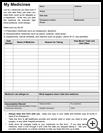
Bronchodilator: Long-Acting Beta2-Agonist (LABA)
________________________________________________________________________
KEY POINTS
- Long-acting beta2-agonist bronchodilators help prevent breathing problems caused by asthma, chronic bronchitis, or emphysema.
- They are taken every day, even when you are not having symptoms. They do not give quick relief of wheezing in acute attacks.
- Make sure you know how and when to take your medicine. Do not take more or less than you are supposed to take.
- Ask your healthcare provider or pharmacist what side effects the medicine may cause and what you should do if you have side effects.
________________________________________________________________________
What is this medicine used for?
Long-acting beta2-agonist bronchodilators (LABA) are used to prevent symptoms caused by asthma, chronic bronchitis, or emphysema. Chronic bronchitis and emphysema are also called chronic obstructive pulmonary disease, or COPD. This medicine is taken every day, even when you are not having symptoms. It is called a controller medicine because when it is taken regularly every day, it helps to control symptoms.
LABAs do not give quick relief of wheezing in acute attacks. For acute attacks, you need a different type of medicine called a reliever.
If you have asthma or COPD, you may have symptoms like coughing, wheezing, and shortness of breath. Your symptoms are caused by 2 different problems in the airways.
- One problem is that the muscles in the airways tighten up, which causes the feeling of chest tightness and wheezing.
- The other problem is swelling, irritation, and too much mucus in the airways.
If you have asthma, your symptoms often start after you are exposed to a trigger. Asthma triggers can include pollen, animals, mold, colds, exercise, cold air, sinusitis, reflux, and air pollutants. It is important to know what things trigger your symptoms so that you can avoid those things or take your reliever medicine before being around a trigger.
LABAs are always used with another type of controller medicine, usually an inhaled steroid. They should never be used as the only treatment for asthma. In people with asthma, long-acting beta2-adrenergic agonists increase the risk of asthma-related hospitalization or death. Talk with your healthcare provider about this. LABAs should be used only for a short time. Your healthcare provider may tell you to stop taking a LABA once other types of daily medicines are controlling your asthma symptoms.
Asthma symptoms come and go throughout the day or week and get better with medicine. COPD symptoms get worse over time and never go away completely.
How does it work?
LABAs relax the muscles of the airways and keep the muscles from getting too tight. When the airway muscles are more relaxed and less tight, you will have fewer symptoms and be able to breathe better. Other medicines used with LABAs can reduce the swelling and inflammation.
LABAs can be taken in different ways. For example:
- A hand-held device, such as a metered-dose inhaler (MDI) or a dry powder inhaler, is small and easy to carry with you. The inhaler helps send the medicine directly to your lungs as you take a deep breath. Some inhalers may need a spacer. A spacer is a small tube or bag that holds the medicine while you breathe it into your lungs.
- A nebulizer is a machine that you can use at home. Medicine is mixed with liquid and the machine forms a mist. You breathe in the mist to help get the medicine into your lungs.
What else do I need to know about this medicine?
- Follow the directions that come with your medicine, including information about food or alcohol. Make sure you know how and when to take your medicine. Do not take more or less than you are supposed to take.
- If possible, rinse your mouth with clear water after you take this medicine.
- Try to get all of your prescriptions filled at the same place. Your pharmacist can help make sure that all of your medicines are safe to take together.
- Keep a list of your medicines with you. List all of the prescription medicines, nonprescription medicines, supplements, natural remedies, and vitamins that you take. Tell all healthcare providers who treat you about all of the products you are taking.
- Many medicines have side effects. A side effect is a symptom or problem that is caused by the medicine. Ask your healthcare provider or pharmacist what side effects the medicine may cause and what you should do if you have side effects.
If you have any questions, ask your healthcare provider or pharmacist for more information. Be sure to keep all appointments for provider visits or tests.

